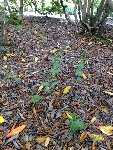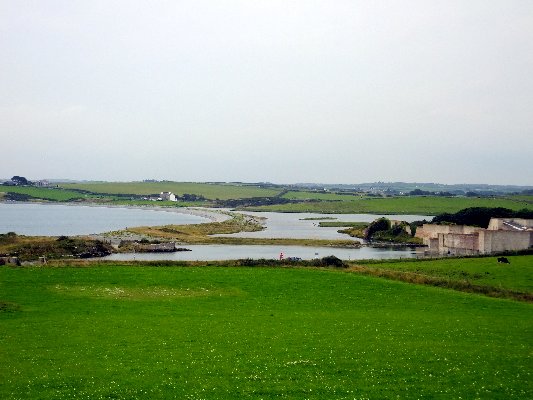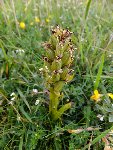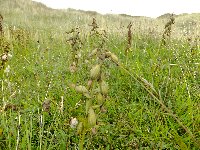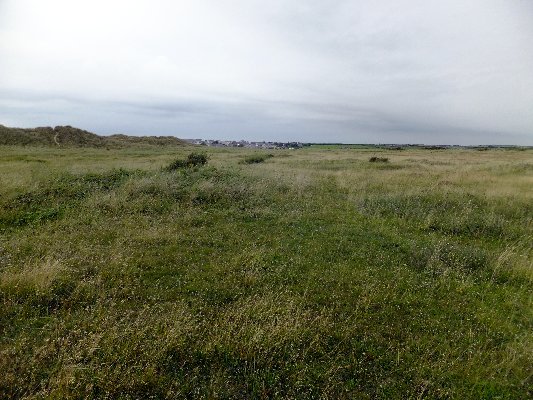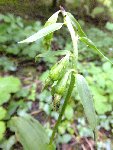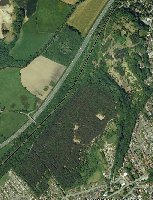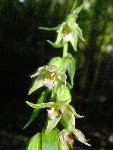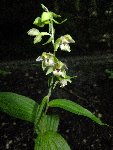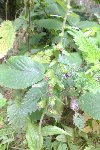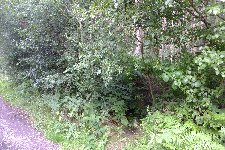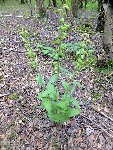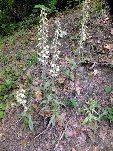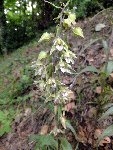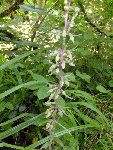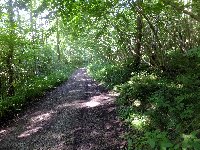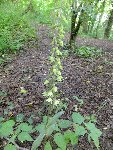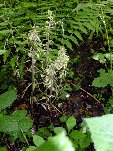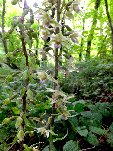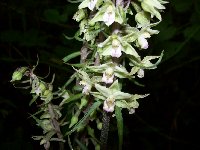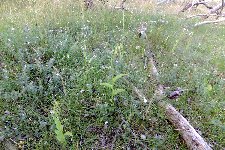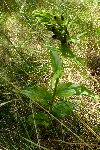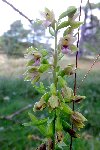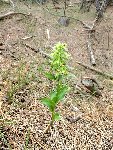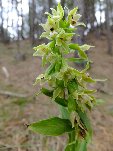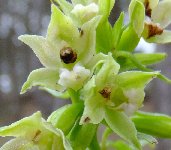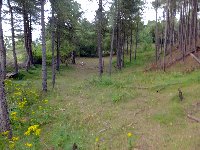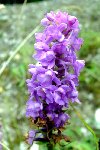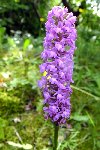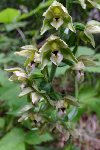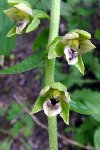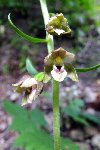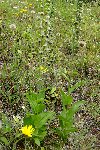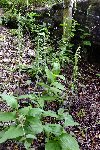|
|
|||||||||
|
|
|||||||||
 |
|
Bodnant Gardens, 30th August 2013 A chance finding this one. A visit to the National Trust's Bodnant Gardens in the Conwy valley, and I spot some Broad-leaved Helleborines under shrubs along the the valley top walk. About 30 spikes are setting seed. Obviously the ground staff know about them and have left them to flower, but I do just have a niggling doubt that they are not naturalised. The NT have seeded areas with wildflowers at other properties (Erddig, Powys Castle) and Common Spotted Orchids have been included. However way way back in 1980 I did see a single spike of BLH growing in the woods alongside the road leading to Bodnant, so it does grow within a mile of this colony.
Aberffraw, Angelsey, 23rd August 2013 This meant to be a trip to find the elusive Autumn Lady's Tresses, and two promising sites had been identified. The first was Cemlyn Bay on Anglesey's north coast. This is an interesting place as a slate shingle beach has formed across the bay creating a lagoon behind it. We set off on the western side looking everywhere that there is well cropped grass; both on the point and in the fields behind. No luck at all. But our trip is cut short. A glance down at the car-park causes a bit of alarm. The incoming tide is over the road. We get back with dry feet but only by edging along the side of a wall. And the rain has started, so refreshments in Cemmaes Bay are in order
We then head for Aberffraw where south of the village is an extensive mature dune system. We are immediately met by another dune plant growing everywhere which is about 10cm tall with lots of tiny white flowers. No ALTs were found but plenty of evidence of earlier orchid flowering. Though seed pods are ripening on the plants it is possible to tentatively identify Early Marsh Orchid, Marsh Helleborine (in lower lying areas and there in great numbers), and Pyramidal Orchids. Next time we go to Anglesey in June or July Aberffraw will feature on the itinerary.
Marford Quarry, 16th August 2013 Previous visits have shown Green-Flowered Helleborines at three close but distinct areas, but a fourth has been reported and I find it exactly where it is expected. While most plants seem to conform to standard var pendula, there are some plants that seem to be setting seed without the flower opening (cleistogamy). There are records of var degenera here and perhaps it was examples like this that led to those reports.
Another re-visit. Last time here I found a solitary Bird's Nest Orchid and some Green-Flowered Helleborines still in bud. Now there is no sign of that BNO, and it does look a bit like it may have been dug up, though I can't be sure the depression I see today is exactly where the orchid grew. The GFH have largely finished flowering but there are enough still in flower to confirm that these are var pendula. It's quite a dull day and they are growing in the darker parts of the woodland so flash had to be used.
Delamere Forest, 15th August 2013 On a previous visit here in July I thought we had found a few Broad-Leaved Helleborines. It has been pointed out since that this looks much more like a Dune Helleborine. In my defense we were looking for BLH, and this habitat is un-alike to any other DH site. Moreover the Dune Helleborines at Alyn Waters were overlooked as BLH for may years.
Around Wrexham, 12th August 2013 Helleborines seem to able to colonise sites before many other plants, especially those formerly industrial and left alone subsequently. A search for such sites in the Wrexham area threw up two former coal mine sites at Gresford and Bersham. A walk around both of these checking as many different vegetations as possible revealed absolutely nothing! So a follow up to Alyn Waters, where many of the Dune Helleborines are setting seed quite successfully. The same cannot be said for the Green Flowered Helleborines. Many of these seem to have had both flower heads and leaves nibbled (presumably by rabbits). I can only surmise they are tasty, while Dune Helleborines are considerably less palatable. I did not put this to a personal test.
Marford Woods, 10th August 2013 A return visit, partly to have another look at the Broad-leaved Helleborines, and partly to re-visit the remains of Horsely Hall and see what can be seen of the gardens there.
Coalbrookdale, 9th August 2013 We set off on another trip to darkest Shropshire hunting down Violet Helleborines. There are two sites that are near each other and have both road and footpath access. And one comes up trumps with two small groups growing about 100 yards apart on the roadside. In total there are 20 flowering spikes, and most are tall and robust plants. The lane runs along the side of a wooded hill, and the VH grow on the slope above the road.
After the Severn Valley we set off for more sites in the area where Violet Helleborines have been reported in the last few years, and chosen for accessibility and access. The first is in the Wyre Forset near Button Bridge, but this draws a blank. The second at Billingsley looks impassable. What should be a footpath through woodland is nothing but mud furrowed by 4x4 ruts, and looked worse than it sounds Success though at Wenlock Edge. There are two reports, close together, in the woodland surrounding the Shropshire way which runs just below the summit of the Edge. Only 5 Violet Helleborines, and all in close bud, but distinct enough to be recognised. There are still some sites left to be investigated; next year perhaps.
Severn Valley Country Park, 3rd August 2013 The first stop on a journey around eastern Shropshire calling at potential sites for the Violet Helleborine. This country park is first stop as it has been confirmed to me that they do grow here. A phone cal to warden confirms this. He tells me where to see them, but hasn't seen them himself recently. He tells me that in addition to the helleborines they have Green Winged and Bee Orchids earlier in the year. The Violet Helleborines are fairly obvious in a rather overgrown bit of deciduous woodland as they are, on the whole, rather tall specimens and their overall paleness stands out amongst the brambles and ivy. We count in excess of 40 spikes, mostly in groups of up to 5, in a relatively small area. Most plants have at least the lower flowers out. The biggest problem is taking photographs in the poor light. Without flash the automatic exposure is much longer than normal and some photos are blurred. Using a flash can make the plants over-exposed. Best to take lots more than needed and discard the rubbish later. Nice place to visit. You can even see the Severn Valley Railway on the western boundary, and the park even has its own halt there.
Ainsdale Dues, 2nd August 2013 A return visit, a week earlier in the year than 2012. Despite this, and the poor spring of 2013, the Dune Helleborines seem to be going over a bit; even before opening fully in some plants. Is this a reaction to the recent hot and dry spell of weather. Is it my imagination, or are these dunensis slightly smaller flowered than those growing at Alyn Waters. I should really go into the field better prepared with a tape measure and magnifying glass; or would that be taking it all to seriously.
Minera Quarry, Wrexham, 1st August 2013 We've been to the quarry several times, but always late June or early July. Consequently we've never seen the Broad-leaved Helleborines in flower; only ever as bent over emerging flower spikes. In fact, it has only been assumed that is what they are. First off though at the entrance to the quarry is a scattering of Marsh Fragrant Orchids. I've not seen these low down in the quarry before, but haven't really been here at the peak flowering time. Actually one large densely flowered plant has features more of a Common Fragrant; pointed deflexed sepals and a less pleasant scent. But this is way off the flowering period for this species, so could it be a densiflora x conopsea hybrid? [this identification has been disputed on Birdforum by those with more experience than me, but I know that both species exist here, and that this specimen had a mix of features from both. So until more information is gained it is a hybrid!] A few helleborines are also in this area but the main accessible colony is on the north side at a gated entrance to a lane. The best place is actually at the base of the sheer walls, but this is fenced off from public access now. Just at the lane, under the hedge on the right and the steep slope is a colony of some 150+ flowering spikes, with more non-flowering plants. There is some variations in colour, but not as much as seen last week at Marford. The colours actually seem duller, and the commonest shade is a dull khaki colour - somehow this does seem to come out so well on the photographs on screen. The peak flowering will probably be next week.
|
|
|
||||||||||||||||||||
